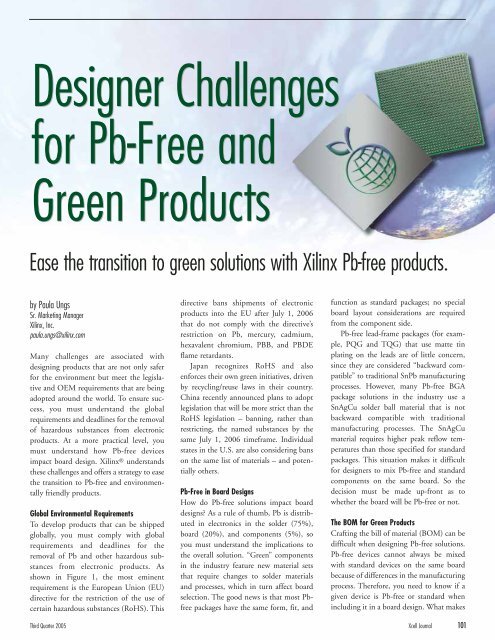Design Challenges: Avoiding the Pitfalls, winning the game - Xilinx
Design Challenges: Avoiding the Pitfalls, winning the game - Xilinx
Design Challenges: Avoiding the Pitfalls, winning the game - Xilinx
Create successful ePaper yourself
Turn your PDF publications into a flip-book with our unique Google optimized e-Paper software.
<strong>Design</strong>er <strong>Challenges</strong><br />
for Pb-Free and<br />
Green Products<br />
Ease <strong>the</strong> transition to green solutions with <strong>Xilinx</strong> Pb-free products.<br />
by Paula Ungs<br />
Sr. Marketing Manager<br />
<strong>Xilinx</strong>, Inc.<br />
paula.ungs@xilinx.com<br />
Many challenges are associated with<br />
designing products that are not only safer<br />
for <strong>the</strong> environment but meet <strong>the</strong> legislative<br />
and OEM requirements that are being<br />
adopted around <strong>the</strong> world. To ensure success,<br />
you must understand <strong>the</strong> global<br />
requirements and deadlines for <strong>the</strong> removal<br />
of hazardous substances from electronic<br />
products. At a more practical level, you<br />
must understand how Pb-free devices<br />
impact board design. <strong>Xilinx</strong> ® understands<br />
<strong>the</strong>se challenges and offers a strategy to ease<br />
<strong>the</strong> transition to Pb-free and environmentally<br />
friendly products.<br />
Global Environmental Requirements<br />
To develop products that can be shipped<br />
globally, you must comply with global<br />
requirements and deadlines for <strong>the</strong><br />
removal of Pb and o<strong>the</strong>r hazardous substances<br />
from electronic products. As<br />
shown in Figure 1, <strong>the</strong> most eminent<br />
requirement is <strong>the</strong> European Union (EU)<br />
directive for <strong>the</strong> restriction of <strong>the</strong> use of<br />
certain hazardous substances (RoHS). This<br />
directive bans shipments of electronic<br />
products into <strong>the</strong> EU after July 1, 2006<br />
that do not comply with <strong>the</strong> directive’s<br />
restriction on Pb, mercury, cadmium,<br />
hexavalent chromium, PBB, and PBDE<br />
flame retardants.<br />
Japan recognizes RoHS and also<br />
enforces <strong>the</strong>ir own green initiatives, driven<br />
by recycling/reuse laws in <strong>the</strong>ir country.<br />
China recently announced plans to adopt<br />
legislation that will be more strict than <strong>the</strong><br />
RoHS legislation – banning, ra<strong>the</strong>r than<br />
restricting, <strong>the</strong> named substances by <strong>the</strong><br />
same July 1, 2006 timeframe. Individual<br />
states in <strong>the</strong> U.S. are also considering bans<br />
on <strong>the</strong> same list of materials – and potentially<br />
o<strong>the</strong>rs.<br />
Pb-Free in Board <strong>Design</strong>s<br />
How do Pb-free solutions impact board<br />
designs? As a rule of thumb, Pb is distributed<br />
in electronics in <strong>the</strong> solder (75%),<br />
board (20%), and components (5%), so<br />
you must understand <strong>the</strong> implications to<br />
<strong>the</strong> overall solution. “Green” components<br />
in <strong>the</strong> industry feature new material sets<br />
that require changes to solder materials<br />
and processes, which in turn affect board<br />
selection. The good news is that most Pbfree<br />
packages have <strong>the</strong> same form, fit, and<br />
function as standard packages; no special<br />
board layout considerations are required<br />
from <strong>the</strong> component side.<br />
Pb-free lead-frame packages (for example,<br />
PQG and TQG) that use matte tin<br />
plating on <strong>the</strong> leads are of little concern,<br />
since <strong>the</strong>y are considered “backward compatible”<br />
to traditional SnPb manufacturing<br />
processes. However, many Pb-free BGA<br />
package solutions in <strong>the</strong> industry use a<br />
SnAgCu solder ball material that is not<br />
backward compatible with traditional<br />
manufacturing processes. The SnAgCu<br />
material requires higher peak reflow temperatures<br />
than those specified for standard<br />
packages. This situation makes it difficult<br />
for designers to mix Pb-free and standard<br />
components on <strong>the</strong> same board. So <strong>the</strong><br />
decision must be made up-front as to<br />
whe<strong>the</strong>r <strong>the</strong> board will be Pb-free or not.<br />
The BOM for Green Products<br />
Crafting <strong>the</strong> bill of material (BOM) can be<br />
difficult when designing Pb-free solutions.<br />
Pb-free devices cannot always be mixed<br />
with standard devices on <strong>the</strong> same board<br />
because of differences in <strong>the</strong> manufacturing<br />
process. Therefore, you need to know if a<br />
given device is Pb-free or standard when<br />
including it in a board design. What makes<br />
Third Quarter 2005 Xcell Journal 101

















